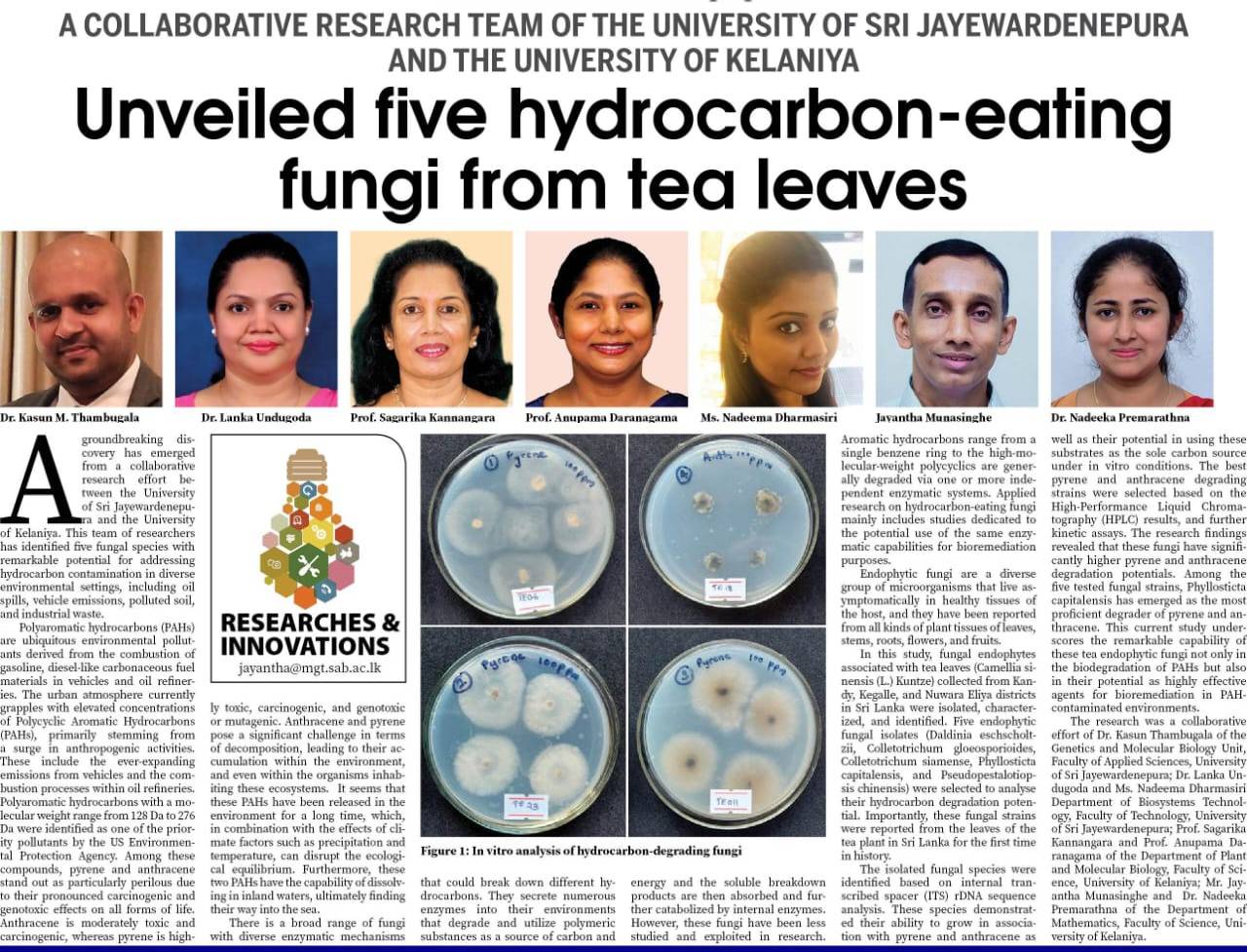A groundbreaking discovery has emerged from a collaborative research effort between the University of Sri Jayewardenepura and the University of Kelaniya. This team of researchers has identified five fungal species with remarkable potential for addressing hydrocarbon contamination in diverse environmental settings, including oil spills, vehicle emissions, polluted soil, and industrial waste.
Polyaromatic hydrocarbons (PAHs) are ubiquitous environmental pollutants derived from the combustion of gasoline, diesel-like carbonaceous fuel materials in vehicles and oil refineries. The urban atmosphere currently grapples with elevated concentrations of Polycyclic Aromatic Hydrocarbons (PAHs), primarily stemming from a surge in anthropogenic activities. These include the ever-expanding emissions from vehicles and the combustion processes within oil refineries. Polyaromatic hydrocarbons with a molecular weight range from 128 Da to 276 Da were identified as one of the priority pollutants by the US Environmental Protection Agency. Among these compounds, pyrene and anthracene stand out as particularly perilous due to their pronounced carcinogenic and genotoxic effects on all forms of life. Anthracene is moderately toxic and carcinogenic, whereas pyrene is highly toxic, carcinogenic, and genotoxic or mutagenic. Anthracene and pyrene pose a significant challenge in terms of decomposition, leading to their accumulation within the environment, and even within the organisms inhabiting these ecosystems. It seems that these PAHs have been released in the environment for a long time, which, in combination with the effects of climate factors such as precipitation and temperature, can disrupt the ecological equilibrium. Furthermore, these two PAHs have the capability of dissolving in inland waters, ultimately finding their way into the sea.
There is a broad range of fungi with diverse enzymatic mechanisms that could break down different hydrocarbons. They secrete numerous enzymes into their environments that degrade and utilize polymeric substances as a source of carbon and energy and the soluble breakdown products are then absorbed and further catabolized by internal enzymes. However, these fungi have been less studied and exploited in research. Aromatic hydrocarbons range from a single benzene ring to the high-molecular-weight polycyclics are generally degraded via one or more independent enzymatic systems. Applied research on hydrocarbon-eating fungi mainly includes studies dedicated to the potential use of the same enzymatic capabilities for bioremediation purposes.
Endophytic fungi are a diverse group of microorganisms that live asymptomatically in healthy tissues of the host, and they have been reported from all kinds of plant tissues of leaves, stems, roots, flowers, and fruits. In this study, fungal endophytes associated with tea leaves (Camellia sinensis (L.) Kuntze) collected from Kandy, Kegalle, and Nuwara Eliya districts in Sri Lanka were isolated, characterized, and identified. Five endophytic fungal isolates (Daldinia eschscholtzii, Colletotrichum gloeosporioides, Colletotrichum siamense, Phyllosticta capitalensis, and Pseudopestalotiopsis chinensis) were selected to analyse their hydrocarbon degradation potential. Importantly, these fungal strains were reported from the leaves of the tea plant in Sri Lanka for the first time in history. The isolated fungal species were identified based on internal transcribed spacer (ITS) rDNA sequence analysis. These species demonstrated their ability to grow in association with pyrene and anthracene as well as their potential in using these substrates as the sole carbon source under in vitro conditions. The best pyrene and anthracene degrading strains were selected based on the High-Performance Liquid Chromatography (HPLC) results, and further kinetic assays. The research findings revealed that these fungi have significantly higher pyrene and anthracene degradation potentials. Among the five tested fungal strains, Phyllosticta capitalensis has emerged as the most proficient degrader of pyrene and anthracene. This current study underscores the remarkable capability of these tea endophytic fungi not only in the biodegradation of PAHs but also in their potential as highly effective agents for bioremediation in PAH-contaminated environments.
The research was a collaborative effort of Dr. Kasun Thambugala of the Genetics and Molecular Biology Unit, Faculty of Applied Sciences, University of Sri Jayewardenepura; Dr. Lanka Undugoda and Ms. Nadeema Dharmasiri Department of Biosystems Technology, Faculty of Technology, University of Sri Jayewardenepura; Prof. Sagarika Kannangara and Prof. Anupama Daranagama of the Department of Plant and Molecular Biology, Faculty of Science, University of Kelaniya; Mr. Jayantha Munasinghe and Dr. Nadeeka Premarathna of the Department of Mathematics, Faculty of Science, University of Kelaniya.


